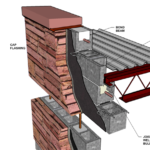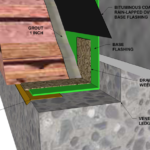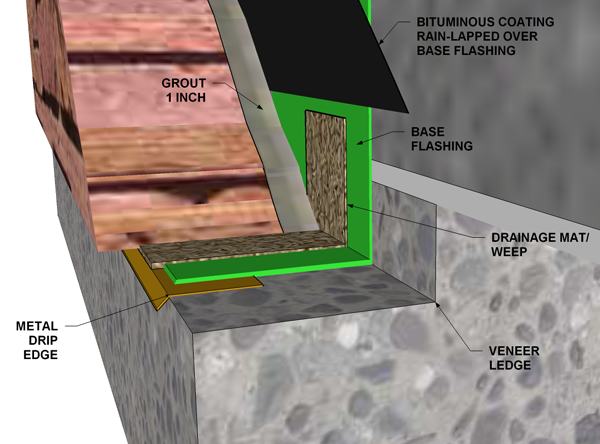Stone Veneer/Reinforced Concrete Block
This solid masonry wall features a structural concrete block backup system with a classic, natural stone façade.

Recommended Building Types
- Commercial and institutional buildings
- High-traffic areas of multifamily residential structures
- High-end single family homes
- Buildings requiring a high fire rating
- Noisy environments
- Choosing the Right Masonry System for your Budget
Benefits
- Solid, classic stone exterior over a structural concrete block backup system – works well in both natural and urban settings
- Great design flexibility, with wide range of colors, surface textures, and bond patterns available
- Most types of stone have exceptional durability and are long-lasting
- Low maintenance
- concrete block backup acts as the structure, with vertical and horizontal reinforcement grouted into place.
- Excellent heat capacity
- Inherently fire proof with fire ratings up to 4 hours
- Great for noisy environments – naturally absorbs sound
- Rough surfaces discourage graffiti
- One trade erects both the structural and skin layers of the wall
Special Considerations
- Be careful using this wall type in wet environments – the lack of the drainage cavity may reduce the life cycle of this wall
- Lower life cycle cost offsets higher initial investment
- It’s not always realistic to expect a perfectly uniform appearance – stone is a natural product and you should expect some variations in color, veining, and surface texture
- Stone can be heavier than brick or block veneers – structural support and foundations may need to be larger
- Install rigid insulation in the cavity or at the interior wall face if you need greater insulating capacity
Definition and Assumptions
Backup: Lightweight plain gray concrete block (CMU), 8″ x 8″ x 16″
Reinforcement: #6 vertical reinforcement at 32″ on center. 9-gauge joint reinforcement at 16″ o.c. (every other course)
Veneer: Rock-faced (split) sandstone, random ashlar pattern. stone thickness varies from 3″ to 4″
Cavity: collar joint, grouted full. Nominal thickness ¾”. Bituminous coating on face of backup
Flashing: Base flashing
Veneer ties: 9-gauge wire hoops adjustable sliding tie system
Mortar: Type N, Portland cement/lime, plain gray
Joints: concave tooled
Regional Variations
- When masonry veneer is used in areas of high seismic risk, Veneer ties are required to attach to wire reinforcement embedded in Mortar bed joints in the veneer. Check your local requirements – and save money by using normal Veneer ties in areas of low seismic risk.
- Many areas of the western U.S. have good local sources for lightweight aggregate, and the use of lightweight concrete block (CMU) is the norm. In other parts of the country, medium weight and normal weight block are more common.
- Structural masonry walls in areas of high seismic risk are required to have additional horizontal bond beams to resist seismic loads. Check with your structural engineer to determine what is required in your region.
- The use of reinforced bond beams can replace the necessity for joint reinforcement in concrete masonry walls. Understand that some form of horizontal reinforcement is required in all concrete masonry construction, including veneer applications.
Fire Rating (hours)
Ungrouted Assembly: 4 hrs
Fully grouted Assembly: 4 hrs
Sound Transmission Class (dB)
Ungrouted: 55.5
Grouted 32″: 57.2
Fully grouted: 61.9
STC=(weight of wall)0.223x21.5
Wall Weight (lb/sq. ft.)
Ungrouted: 71 lb/sq. ft
Grouted 32″: 82 lb/sq. ft
Fully grouted: 115 lb/sq. ft
Energy Rating
R-value: 2.92 (see note below)
Calculation:
| Outside Air | =0.17 |
| Stone 4 inch | =0.62 |
| 8 inch CMU 105 pcf, grouted at 32″ o.c | =1.45 |
| Interior Air | =0.68 |
| Total | =2.92 |
- R-Value/U-Factor Calculator (configurable)
- Introduction to Energy Performance of Brick Masonry
- Indiana Limestone Institute of America
Note: Install rigid insulation and gyp board on the inside face of the wall for greater R-value.
Sustainability & LEED
- Energy efficiency, thermal comfort and energy analysis – up to 10 pts
- Innovation and design – 1 pt
- Recycled content – 2 pts
- Regional material (where applicable) 2 pts
- Concrete Masonry and the LEED Program
- Determining the Recycled Content of Concrete Masonry Products
Design Tips
- Anchored veneer will last longer than adhered veneer
- Denser stones generally are more durable and more water repellent than lighter-weight or more absorbent stones
- The fully grouted space behind the stone veneer stabilizes the rough and uneven rubble stone of the veneer. It is possible to build this wall type with a drainage cavity behind the veneer, especially if the stone is regularly coursed.
- Take special precautions when using limestone to prevent alkali staining: isolate limestone from concrete backup materials and from soil.
- Natural stone is usually stable but will respond to temperature variations; some stones also swell slightly when they get wet. Remember to include movement joints to minimize cracking potential.
- Some new drainage plane products work well in this wall system.
- stone veneers can be expensive – maximize the visual impact and keep costs down by using stone in only the first few stories, or as a short wainscot around the building. Use brick or concrete masonry above the stone.
- shelf angles may not be required for veneer support at every floor line. Cut down on the number of shelf angles to save money and simplify your construction. If your veneer is shorter than 30 feet above the top of the foundation wall, you may not need relieving angles at all.
Construction Tips
- It’s difficult to build most stone veneers with a drainage cavity because of the variable stone thickness. Usually it is easier to apply a water-resistive barrier to the face of the backup concrete block wall, and slush the collar joint full as the stone is being laid.
- Some masons use temporary tie wires to hold rubble stone or river rock in place until the Mortar cures. Ordinary baling wire corrodes quickly and can stain stone. Use stainless steel wires to avoid having to clean rust stains off newly placed stone.
- Lay sandstone, slates, and other similar stone with the bedding planes horizontal.




